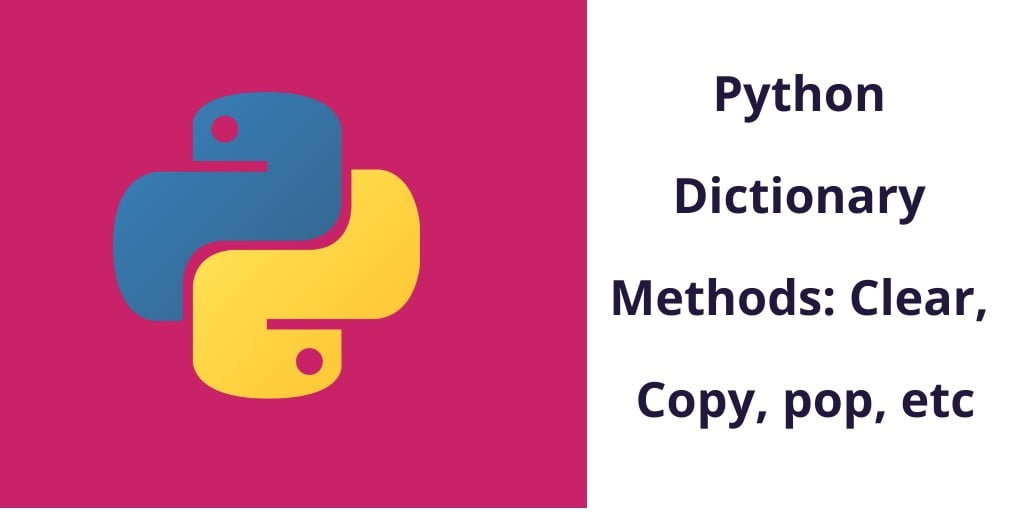In the previous tutorial, you learned how to use in-built lists methods in your Python program. But, In this post, you will learn python built-in dictionary methods/functions.
If you want to know more about python dictionary click here.
Python Dictionary built-in Functions/Methods
Python provides many in-built methods/functions for the dictionary, which is works with python dictionary datatype. And you can modify and manipulate the python dictionary by using built-in dictionary methods/functions of python.
We have provided a list below. Almost all built-in dictionary methods/functions python are there:
| Method | Description |
|---|---|
| clear() | Removes all the elements from the dictionary |
| copy() | Returns a copy of the dictionary |
| fromkeys() | Returns a dictionary with the specified keys and value |
| get() | Returns the value of the specified key |
| items() | Returns a list containing a tuple for each key value pair |
| keys() | Returns a list containing the dictionary’s keys |
| pop() | Removes the element with the specified key |
| popitem() | Removes the last inserted key-value pair |
| setdefault() | Returns the value of the specified key. If the key does not exist: insert the key, with the specified value |
| update() | Updates the dictionary with the specified key-value pairs |
| values() | Returns a list of all the values in the dictionary |
Clear Dictionary Python
The clear() method is used to remove all the elements/items from the python dictionary.
# python dictionary
my_dict = {'name': 'john', 'age': '28'}
my_dict.clear()
print(my_dict)
#output { }
Python Copy dictionary
The copy() method is used to a copy of the specified python dictionary.
# python dictionary
my_dict = {'name': 'john', 'age': '28'}
x = my_dict.copy()
print(x)
#output {'name': 'john', 'age': '28'}
Dictionary fromkeys Method Python
The fromkeys() method used to a dictionary with the specified keys and the specified value.
x = ('key1', 'key2', 'key3')
y = 0
my_dict = dict.fromkeys(x, y)
print(my_dict)
#{'key1': 0, 'key2': 0, 'key3': 0}
Python dictionary get method
The get() method is used to get the value of the item with the specified key.
# python dictionary
my_dict = {'name': 'john', 'age': '28'}
x = my_dict.get('name')
print(x)
#output john
Python dictionary items method
The items() method returns a view object. The view object contains the key-value pairs of the dictionary, as tuples in a list.
# python dictionary
my_dict = {'name': 'john', 'age': '28'}
x = my_dict.items()
print(x)
#output dict_items([('name', 'john'), ('age', '28')])
Python dictionary keys method
The keys() method returns a view object. The view object contains the keys of the dictionary, as a list.
# python dictionary
my_dict = {'name': 'john', 'age': '28'}
x = my_dict.keys()
print(x)
#output dict_keys(['name', 'age'])
Dictionary pop method python
The pop() method is used to remove the specified item from the dictionary.
# python dictionary
my_dict = {'name': 'john', 'age': '28'}
x = my_dict.pop('name')
print(x)
#output john
Python Dictionary popitem() Method
The popitem() method used to remove the item that was last inserted into the dictionary.
# python dictionary
my_dict = {'name': 'john', 'age': '28'}
x = my_dict.popitem()
print(x)
#output ('age', '28')
Python Dictionary update() Method
# python dictionary
my_dict = {'name': 'john', 'age': '28'}
my_dict.update({"fav_color": "White"})
print(my_dict)
#output {'name': 'john', 'age': '28', 'fav_color': 'White'}
Python Dictionary values() Method
The values() method is used to return a view object. The view object contains the values of the dictionary, as a list.
# python dictionary
my_dict = {'name': 'john', 'age': '28'}
x = my_dict.values()
print(x)
#output dict_values(['john', '28'])
